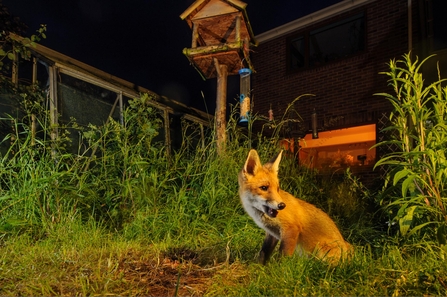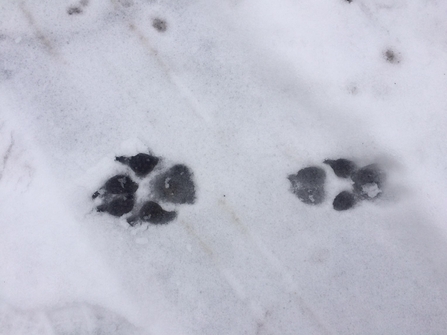Foxes are fantastic at excavating dirt and live underground in homes called earths or dens. If fortunate enough to find a sheltered area as is the case for our foxy friend in our video who has made themselves quite at home in this sunny spot, they can be found living above ground too.
The 12 days of a (wildlife) Christmas - Three fox dens
Red Fox (Vulpes vulpes) Vixen in the Snow during winter, Cannock Chase, Staffordshire - Danny Green/2020VISION
Fox stretching (https://vimeo.com/378262240)
Fox stretching
As determined by a survey carried out in 2018, population numbers of foxes are at an estimated 357,000 with a large proportion of this number believed to be living in urban settings with 150,000 thought to be sharing our gardens and green spaces with us denning within them. Living in small family groups consisting of a dog, vixen, cubs and a couple of young female helpers from previous litters, the family will maintain a territory and have several lairs as well as one or more breeding dens within it.
Rural foxes are much more elusive than their urban friends being very shy and secretive whereas in the towns their bolder counterparts are often seen tip toeing about the streets, local green spaces or parks and many of you have reported being lucky enough to have some denning and visiting in your gardens!

Terry Whittaker - 2020VISION
Although often thought of as carnivorous, foxes are omnivores and have a varied diet from the typically associated prey of rabbits, rats and birds to the more surprising frogs, earthworms, berries and fruit.
Whilst the winter is a time for many animals to take it easy and slow down in activity, this is when foxes are busy mating with winter being the best time to hear foxes’ haunting calling cries. Whilst they have a repertoire of about 28 different vocalisations from these well-known screams to their dog like barks, they mostly use just these two out of their range of calls.
Come the springtime between March and May, the female will give birth to around four to seven pups which can be identified by their black fur and white tipped tails.
We were lucky enough a couple of years ago come across two fluffy fox cubs in Holywells Park. After hearing their cries calling to their mother, we peered under a hedge to be rewarded with a view of two of the cubs. Whilst we haven’t seen any foxes recently in Holywells Park, the park itself and the surrounding areas with allotments and gardens provide great habitats for foxes and we think it may just be a case of them evading us of late. We have however, been treated with sightings of foxes in Christchurch Park regularly when hosting night safari walks in the park and we even managed to record one on our night vision monocular as seen below.
As is often the case with wildlife, we don’t see the species itself but get left little clues as to who may have traipsed through an area leaving either fur, droppings or prints. A great way to determine between fox prints and dog prints, which they are commonly confused with, is by seeing if you can make an imaginary cross through the print without hitting the pads. If, when drawing a cross through you hit the pads, it’s a dog print, if you miss the pads then it’s a fox print. Typically fox prints are more diamond in shape too. We found some beautifully clear prints a couple of years ago in the snow which nicely shows their diamond shape. This is a great activity to do when out on a walk looking in muddy edges and patches or perhaps in your back gardens if you suspect there may be a fox nearby!

Whether you live in an urban setting within Ipswich or you are outside of town in rural locations, most of us will have been lucky enough to have seen a fox padding about. We would love to hear any stories that you might have about foxes in Ipswich or other areas too. Perhaps you’re lucky enough to find have some foxes sharing your garden with you and you’ve been able to identify some prints?

